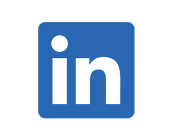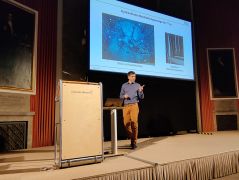MLZ is a cooperation between:
 > Technische Universität München
> Technische Universität München > Helmholtz-Zentrum Hereon
> Helmholtz-Zentrum Hereon
 > Forschungszentrum Jülich
> Forschungszentrum Jülich
MLZ is a member of:
 > LENS
> LENS > ERF-AISBL
> ERF-AISBL
MLZ on social media:

MLZ (eng)
Lichtenbergstr.1
85748 Garching
11.04.2025
Lighter, firmer, hotter: lecture at the Deutsches Museum
In front of around 300 viewers in the live stream and on site at the Deutsches Museum, Dr. Michael Hofmann showed how indispensable research with neutrons is for the development of lighter, stronger materials that can be used at higher temperatures.

Michael Hofmann demonstrated how a rail bends when a train runs over it during his presentation using a pointer stick. © Deutsches Museum
These materials are exposed to high stresses in an engine block, a railroad track or a gas turbine, for example. Casting, forming or hardening in the manufacturing process creates internal stresses, which Michael Hofmann can determine using neutrons at the research neutron source. He is head of the residual stress and texture group at the MLZ and is responsible for the STRESS-SPEC neutron diffractometer. Hofmann vividly introduced the audience to the measurement of residual stresses and showed how this is useful in the production of better materials for the automotive industry or gas turbines.
Gold examined with neutrons
In addition to the engineering and technical research examples, Michael Hofmann also had something for history buffs in his repertoire: archaeologists used his scientific instrument to examine gold and iron finds from the Celtic period with neutrons in order to find out how they were made.

The rows of seats in the Deutsches Museum were sold out for Michael Hofmann's lecture. © Andrea Voit, FRM II / TUM
Is stress in rails desired?
The great interest of the audience was evident after the presentation. Many asked questions or crowded Michael Hofmann after the official Q&A session. One gentleman wanted to know whether residual stresses in rails were actually desirable. Michael Hofmann knew: “In the rail’s head, the residual stresses caused by the manufacturing process are not harmful during operation. In the foot, they must not exceed a certain value.” Other questions that occupied the audience included the number of neutrons that arrive at Michael Hofmann’s measuring instrument (10 million per second and square centimeter) and how the neutrons are guided to the instrument.
Further Information:
Since 2016, a scientist from the FRM II or MLZ has appeared once a year at the “Wissenschaft für Jedermann” (Science for Everyone) event series at the Deutsches Museum. In addition to the on-site lecture, a live stream has also been available since the COVID pandemic and the entire presentation can be viewed afterwards on the YouTube channels of the Deutsches Museum and FRM II.
Michael Hofmanns lecture – as well as many others from the series “Wissenschaft für Jedermann” – can be found on YouTube.
Related News
-
02.05.2024
Ice-cold screening
MLZ is a cooperation between:
 > Technische Universität München
> Technische Universität München > Helmholtz-Zentrum Hereon
> Helmholtz-Zentrum Hereon
 > Forschungszentrum Jülich
> Forschungszentrum Jülich
MLZ is a member of:
 > LENS
> LENS > ERF-AISBL
> ERF-AISBL
MLZ on social media:





